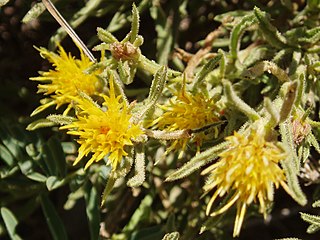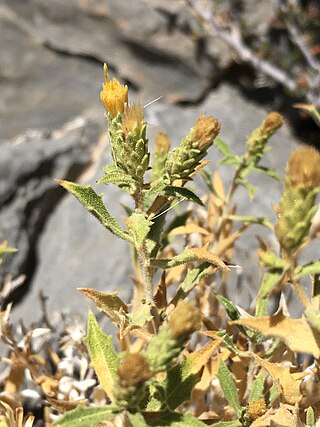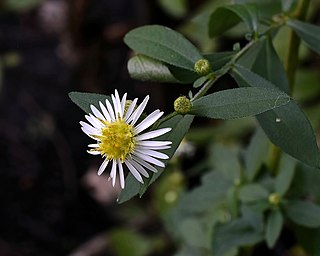
Ionactis, common name stiff-leaved asters or ankle-asters, is a small genus of plants belonging to the family Asteraceae. These aster-like plants are endemic to North America. One species is widespread across much of the eastern half of the continent, while two others are rare endemics with very restricted ranges.

Symphyotrichum is a genus of over 100 species and naturally occurring hybrids of herbaceous annual and perennial plants in the composite family, Asteraceae, most which were formerly treated within the genus Aster. The majority are endemic to North America, but several also occur in the West Indies, Central and South America, as well as one species in eastern Eurasia. Several species have been introduced to Europe as garden specimens, most notably New England aster and New York aster.

Hazardia is a small genus of North American flowering plants in the family Asteraceae. Plants in this genus may be called bristleweeds or goldenbushes.

Symphyotrichum lateriflorum is a species of flowering plant in the aster family (Asteraceae). Commonly known as calico aster, starved aster, and white woodland aster, it is native to eastern and central North America. It is a perennial and herbaceous plant that may reach heights up to 120 centimeters and widths up to 30 centimeters.

Ericameria discoidea, commonly known as whitestem goldenbush or sharp-scale goldenweed is a species of flowering shrub in the family Asteraceae. This plant is native to the western United States from California, Oregon, Nevada, Utah, Colorado, Idaho, and Montana.

Isocoma acradenia is a North American species of flowering plant in the family Asteraceae known by the common name alkali goldenbush.
Erigeron chrysopsidis var. austiniae is a species of flowering plant in the family Asteraceae known by the common name sagebrush fleabane. It is sometimes considered a full species, Erigeron austiniae. It is native to the western United States from northeastern California to southwestern Idaho, where it grows in the sagebrush and juniper woodlands. It is a small, clumping perennial herb producing a hairy stem up to about 12 centimeters tall from a woody caudex and taproot surrounded by narrow linear to somewhat oval leaves up to 8 centimeters long. The inflorescence is a solitary flat-topped woolly flower head containing many yellow disc florets. There occasionally appears a yellow ray floret, but they are usually absent. The fruit is an achene with a pappus of bristles.

Erigeron petrophilus is a species of flowering plant in the family Asteraceae known by the common names rockloving erigeron or cliff fleabane. It is native to the mountain ranges of California from Siskiyou County south as far as San Luis Obispo County and El Dorado County. It also grows in southwestern Oregon.

Erigeron reductus is a species of flowering plant in the family Asteraceae known by the common name lesser California rayless fleabane. It is endemic to California, from Trinity County south as far as Alameda County and El Dorado County.

Adiaphila brickellioides is a species of shrub in the family Asteraceae known by the common name brickellbush goldenweed. It is native to the Mojave Desert of California and Nevada, where it grows in rocky limestone habitat.
Ericameria gilmanii is a rare North American species of flowering plants in the family Asteraceae known by the common names Gilman's ericameria, Gilman's goldenbush, Gilman goldenweed, and whiteflower goldenbush. It is endemic to California, where it has been found in and east of the southern Sierra Nevada, in Inyo County and on Owens Peak in northeastern Kern County. It is a poorly known plant. There are six known populations, but only one has been observed in the last 20 years. Updating as of 2023, several observations of at least two populations have been observed since 2011.

Symphyotrichum dumosum is a species of flowering plant of the family Asteraceae commonly known as rice button aster and bushy aster. It is native to much of eastern and central North America, as well as Haiti and Dominican Republic. It is a perennial, herbaceous plant that may reach a height of 1 meter.
Erigeron klamathensis is a North American species of flowering plant in the family Asteraceae known by the common name Klamath fleabane or Klamath daisy. It had been collected by botanists for many years and generally regarded as part of E. foliosus. It was not recognized as a distinct species until 2004.

Erigeron poliospermus is a species of flowering plant in the family Asteraceae known by the common names gray-seeded fleabane, purple cushion fleabane, and hairy-seed fleabane. Native to western North America, it is mainly found to the east of the Cascade Range in Washington, Oregon, and Idaho.

Adeia whitneyi, common name Whitney's bristleweed, is a North American species of shrub in the daisy family. It has been found only in the state of California in the western United States.

Symphyotrichum patens, commonly known as late purple aster or spreading aster, is a perennial, herbaceous plant found in the eastern United States.

Symphyotrichum ontarionis is a species of flowering plant in the family Asteraceae native to eastern North America. Commonly known as Ontario aster and bottomland aster, it is a perennial, herbaceous plant that may reach heights of 120 centimeters. Each flower head has many tiny florets put together into what appear as one.

Symphyotrichum racemosum is a species of flowering plant native to parts of the United States and introduced in Canada. It is known as smooth white oldfield aster and small white aster. It is a perennial, herbaceous plant in the family Asteraceae. It is a late-summer and fall blooming flower.

Symphyotrichum spathulatum is a species of flowering plant in the family Asteraceae native to western North America including northwestern Mexico. Commonly known as western mountain aster, it is a perennial, herbaceous plant that may reach 20 to 80 centimeters tall. Its flowers, which open in July and August, have violet ray florets and yellow disk florets.

Adeia discoidea is a species of flowering plant in the sunflower family, Asteraceae. It is a perennial herb or subshrub native to California and Oregon.

















